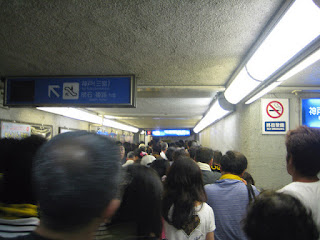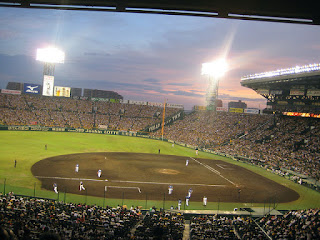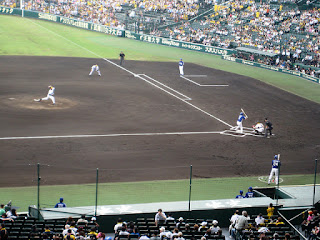On the Reality of Culture Shock
 |
| Koshien Stadium, 2010 |
Wednesday, June 30, 2010
Chunichi Dragons vs. Hanshin Tigers Koshien Stadium
Central League, Nippon Professional Baseball
Nishinomiya, Japan
16:00
Outside of the Game:
After what was my first legitimately good night's sleep of the entire trip so far, I decided to celebrate with the Washington Plaza's breakfast buffet, followed by a victory soak in the tub. The hotel included some odd bath salts to enhance the experience, and they turned the water an unhealthy shade of green. That said, after testing to make sure I wouldn't end up looking like Kermit the Frog at the end of the experience, the hot soak in the green stuff with the ambient music machine turned up full blast was perhaps as relaxed as I've been in a very long time.
I had until a night game to kill, so I did more wanderings about the capitalist orgy of Osaka. I started out going to Sennicimae Doguya Street, which is another of the specialty markets in town. This one sells restaurant supplies. This isn't just limited to things such as utensils and cooking apparatus, but also signs and things similar. Most importantly, you know all those plastic display foods that the restaurants have in their front window or counter? They come from someplace, and that someplace is likely here. Space constraints in my suitcase was all that prevented me from buying a big plastic display bowl of niku udon, although I did go a little nuts on chopsticks and other tableware.
 |
| Need a fake food display? There's a store for that. |
It is at this point that timing and tactical errors came into play. Osaka is well-known for its food, so I wanted to make sure I sampled some of the local cuisine for lunch. One of the highest-regarded udon places in the city was right by my hotel, but it turns out that it is closed Wednesdays. I decided instead to go to a traditional Japanese pancake (okonmiyaki) place down the street. I was seated in front of the chef's grill, ordered a pork pancake, and went on planning the rest of the afternoon. As I took my first bite of my lunch, I noticed the chef grilling up a prawn pancake on the same grill on which he made mine.
A cultural exchange quickly followed. I was eventually able to communicate that I did not spit out my food because I did not like it, but because the chef had just committed attempted murder. Even with the limited contact to shellfish, I had a mild allergic reaction, but nothing too serious. Once again, the mortification of the staff was immense, but in this case, I was more inclined to accept it. I have to imagine I would be dead if I stayed in Japan for a month due to cross-contamination.
The brush with death behind me, I forged on to Osaka Castle. The thing about castles is that they were made to be hard to get to, so it was a bit of an adventure finding out how to breach each successive series of moats and walls, even with helpful maps to show the way. Eventually, my marching and counter-marching was successful enough to get my to the castle itself. As with most things in Japan, it is a reconstruction built on the original foundations. I tried to get change for my 10,000 yen note before buying a ticket from the ticket machines, but the attendant told me it would be okay (mildly amused by my concerns), and lo and behold, the machine in fact gave out change in coins and bills in multiple denominations. It's the future right now, people.
 |
| Castle gardens |
I had enough time, so I got an audio tour for the festivities, and then went up to the top floor to take the ever-present "suggested route" from the top down, which progressively gave the (often grisly) history of the castle from its inception, to its construction as an impenetrable fortress, to its subsequent multiple captures, razings, and rebuildings, to the modern day. There was a particularly noteworthy diorama made of one of the major battles at the castle that was illustrated in a famous paneled silk screen. In a bow to consumerism, you could even dress up as a samurai and have your photo taken. I demurred and finished up the tour, took a walk around the castle temple and gardens, and then headed back to the hotel to switch up gear for the game.
I had to take an auxiliary train line out to the game, but it was a straight shot and went without incident on the way out. On the way back, I got my first real taste of what I'd come to expect of using public transportation when leaving a major sporting event. The entrance to the train station was a sea of people for the length of a good football field. Once you managed to get through the turnstile gates, the corridors to the trains themselves were a cattle ramp of humanity. But the people were, for the most part, patient and behaved, and as trains kept arriving as a regular clip, it was nothing like the sea of agony that comes with trying to get an orange line train after a Yankees game, or trying to get to the 7 at Shea before they made the station renovations last year.
 |
| Deep breath, keep moving |
I got back to the hotel, picked up my laundry, and pretty much settled in for the night. The crush back to the trains had left me famished for some reason, so I absolutely inhaled a box of base cookies from the Koshien Museum (after arranging them first in proper diamonds), worked on the scorecard a little, and then made sure everything was packed up for my train back to Tokyo the next morning.
The Stadium & Fans:
 |
| Center field to home plate at Koshien Stadium |
The train station for the park dumps you off across the street and a large plaza from the stadium proper. The plaza is flanked on one side by a big fan pavilion filled with food and merchandise stalls, with the big official team store on one side and the majestic tiger statue perched at the crossing to get to the stadium.
Hanshin Tigers fans are well-known as the most fervent in Japan, and their home stadium at Koshien is one of the historical jewels of the league, home not just to the long-lived Tigers, but also the most famous high-school baseball tournament in the country. Imagine, if you will, that Fenway Park also hosted the NCAA Final Four championship every year, and you can sort of get the scope of what this park means.
 |
| Baseball as religion |
And I'd also like to definitively answer the question of whether Japanese or American fans are more devoted to baseball. And I will answer it with this: around the back of Koshien Stadium is a Shinto shrine -- an actual religious place of worship. In that shrine is a statue to baseball, and that may be enough to seal the deal, but next to the shrine proper is a Hanshin Tigers merchandise store and a Tiger's logo above the place to leave prayers and devotions. Let's just think about that for a moment, shall we? Can you imagine a giant baseball in St. Patrick's Cathedral? With a Yankee's logo above the devotional candles or a Mets merch store by the altar? If that doesn't just blow your mind, you aren't paying proper attention.
 |
| Baseball devotional statue |
There is a walkway all around the stadium, housing the usual suspects such as ticket booths, team stores, merchandise stalls, places to get your photo taken with the mascots and the rest. There is also a small park laid out in a baseball diamond with a small monument to Babe Ruth in "right field." The Tigers have also embraced some of the finer points of MLB marketing, as they have a fan brick walk in front of one of their entrances.
 |
| Babe is universal |
This is the Tiger's 75th anniversary, and as part of the festivities, they have opened a museum about Koshien Stadium. The museum is half about the stadium and half about Tigers themselves, and since there was no English version of the pamphlet, I understood perhaps a third of everything. There was areas on the history of the team and the history and construction of the stadium, the championships the franchise has won over the years, as well as retired number area for the great players and a hall of fame with plaques. I'm unsure what the difference was between the later two areas. Another section of the museum talked about the history of the high school baseball tournament that plays yearly in the stadium. There were other areas on the construction and history of the stadium and the effect of manga on baseball in Japan, and the Tigers in particular. There was also an interesting exhibit on the scoreboard at Hanshin Stadium. To the best of my understanding, it used to be a manual scoreboard until very recently, and most of the player names that were put up there were hand-painted by the scoreboard keeper. The exhibit itself was lined with examples of those tiles. What I imagine is the highlight of the visit is a chance to go out onto the deck below the center field scoreboard and peek through the batter's eye during batting practice. (The special tarmac that they put up for this is taken down during the game.) Even though I didn't understand anything not in English, the museum was actually very well done.
 |
| Hall of Fame in the Museum |
The stadium is one deep bowl that circles the entire playing field, with a second luxury and broadcast area above home plate. The Tigers have also latched onto another new piece of MLB fashion by having a mini LCD screen going around the barrier between the lower and upper decks behind home plate, in addition to the main scoreboard in center and the smaller board behind home plate. The left and right sections of the lower deck are accessible to ticket-holders in either area, but the area behind home plate and the outfield cheering areas are only accessible with tickets to those areas. I didn't even bother to try and get into the luxury area.
The infield is all dirt with no grass, and from what I can tell, this used to be the style in most Japanese parks, though more recently most have switched to the American style of grass (or, more likely, turf) surrounding the pitching mound area. The old way is preserved there.
Much talk has been made of the Tigers and their fans, and it is borne out by two things. Firstly is that a ticket to a Tigers game is one of the hardest to get in all of Japan, as the team gets near capacity for most of its games. The second is that the opposing cheering section, while present, was only in a tiny section of part of the left field bleachers. Tigers fans dominated the entire stadium except for that postage-stamp spot of blue out in the boonies of the seating area populated by visiting fans that had found a way to get seats.
And the crowd was the largest and loudest I had experienced up until this point. It wasn't just the hardcore fans leading the cheers in the right field bleachers and the rest of the crowd adding some muted support. The entire crowd was loud from start to finish, to the last pitch in the last at-bat. To their credit, the small contingent of Dragons fans did make themselves heard, but the Tigers fans had them on sheer volume, to say nothing of enthusiasm.
 |
| Now, that's a balloon launch |
The balloon launch in the 7th inning was particularly impressive with a full house of amped fans. It actually took the grounds crew a little while to clear all the balloons off the field.
At the Game with Oogie:
 |
| Packed in tight |
As this was a Tiger's home game, it was packed to the gills, and likely a sell-out. I was half-way up the bowl right behind third base, which gave a slightly better view of the field because it was just above the foul ball fencing that circled the park. There were all Tigers fan around me, most notably a team of little leaguers just in front and to the right of me. In a somewhat perplexing turn of events, they had their names sewn on their uniform, but Velcro attachments for their numbers. One would think that their names would be the thing that you'd want to be able to change easily, but perhaps their number for the game reflects what position they are playing. That's at least the best guess that I was able to come up with.
The Game:
 |
| First pitch, Dragons vs. Tigers |
This was a tightly fought match-up from start to finish. The first three innings went fairly briskly for both teams. In the top of the fourth, the Dragons clean-up hitter Wada sent one out of the park in right field to break up what otherwise was another 1-2-3 inning. The Tigers came right back in the bottom of the fourth. A leadoff single was erased on a caught stealing, but three more singles in the inning brought across the tying run. The Dragons threatened again in the top of the fifth with a leadoff double that moved to third with one out on a fielder's choice, but the Dragons couldn't get him home. Both teams traded missed opportunities for next few innings (the Dragons got bases loaded with no one across in the 7th, and the Tigers stranded a couple on base in the same period) before the Dragons broke through in the 8th. A leadoff single was sacrificed over to the second and then brought home on a single. The Tigers stopped the bleeding there, throwing out that runner at home when he tried to score on a double to right, but they could do nothing the next two innings, and the Dragons held on for the win, 2-1. I had seen the Tigers twice so far, and they had lost both times.
One additional item of note was the fact that they used little electric golf carts to bring in the relievers from the bullpen. It was was just one other thing to hearken back to late 70s baseball (as long as you replace the electric cart with a gas-guzzling Lincoln, but you get the picture.)
The Scorecard:
Dragons vs. Tigers, 06/30/10. Dragons win, 2-1.
I used the Scoremaster again. The only scorings of note were a 1-6 fielder's choice put-out against the Tigers and two outfield assist put-outs against the Dragons in the eighth inning.
The Accommodation:
Once again, I was at the Washington. The humidity being what it was, I left a couple pairs of my pants to be laundered the night before, and due to some translation errors, I wasn't able to pick them up until after the game instead of before.
2010 Japan I






No comments:
Post a Comment